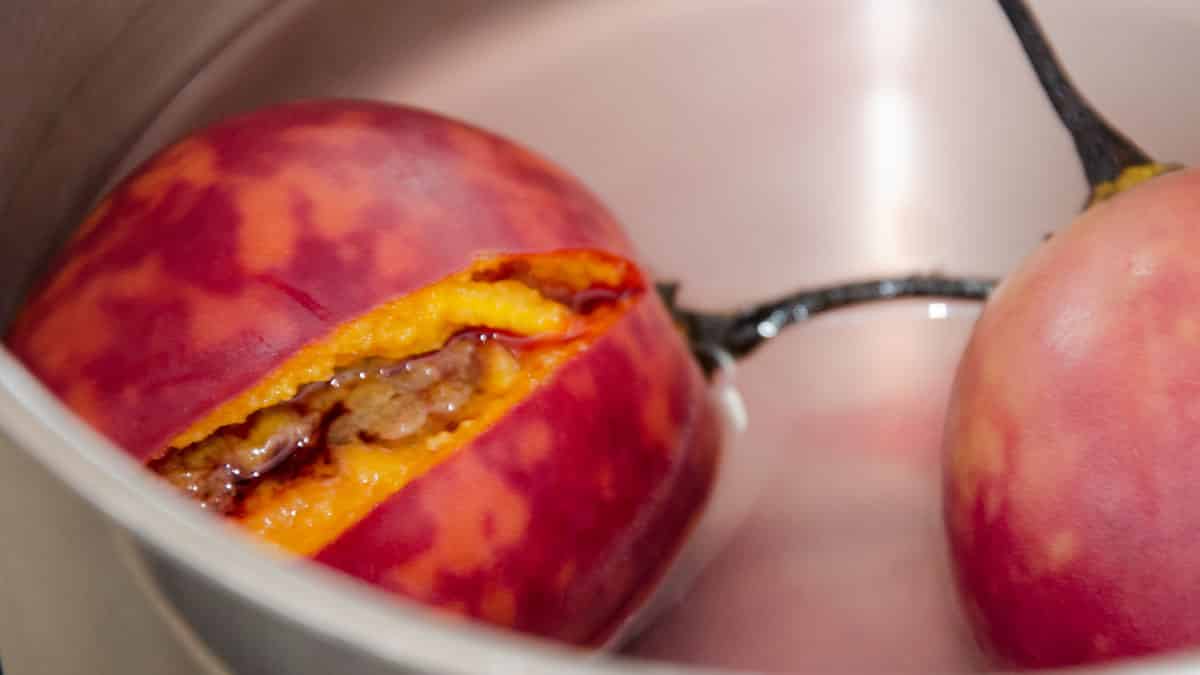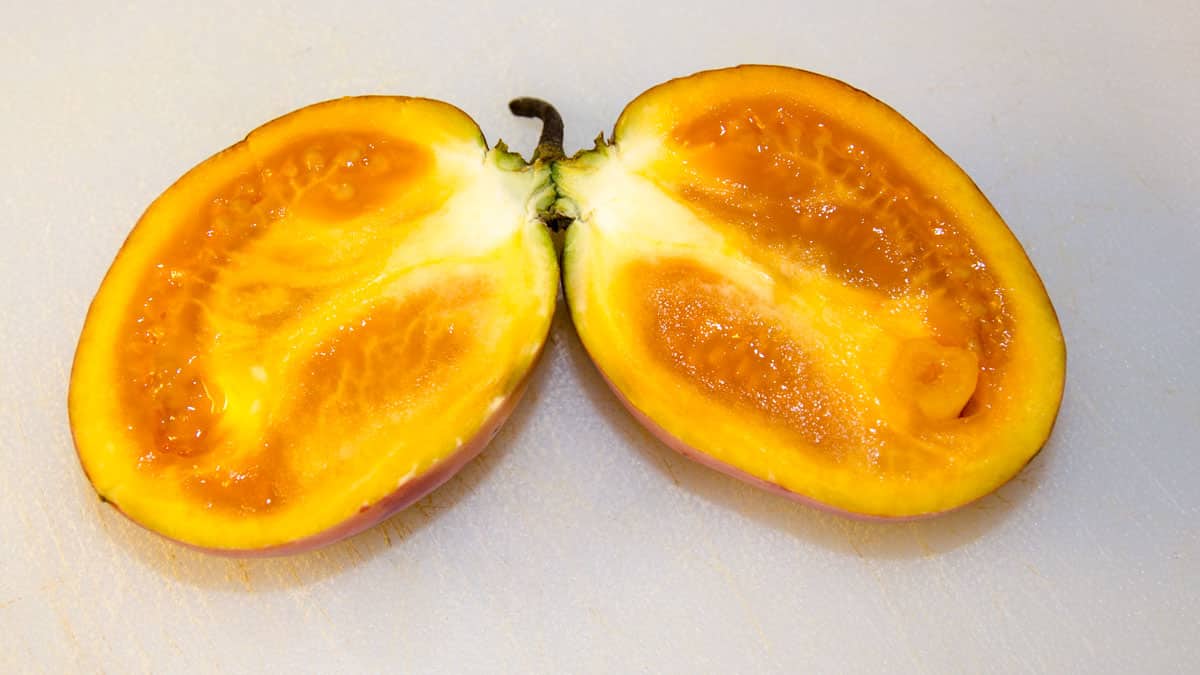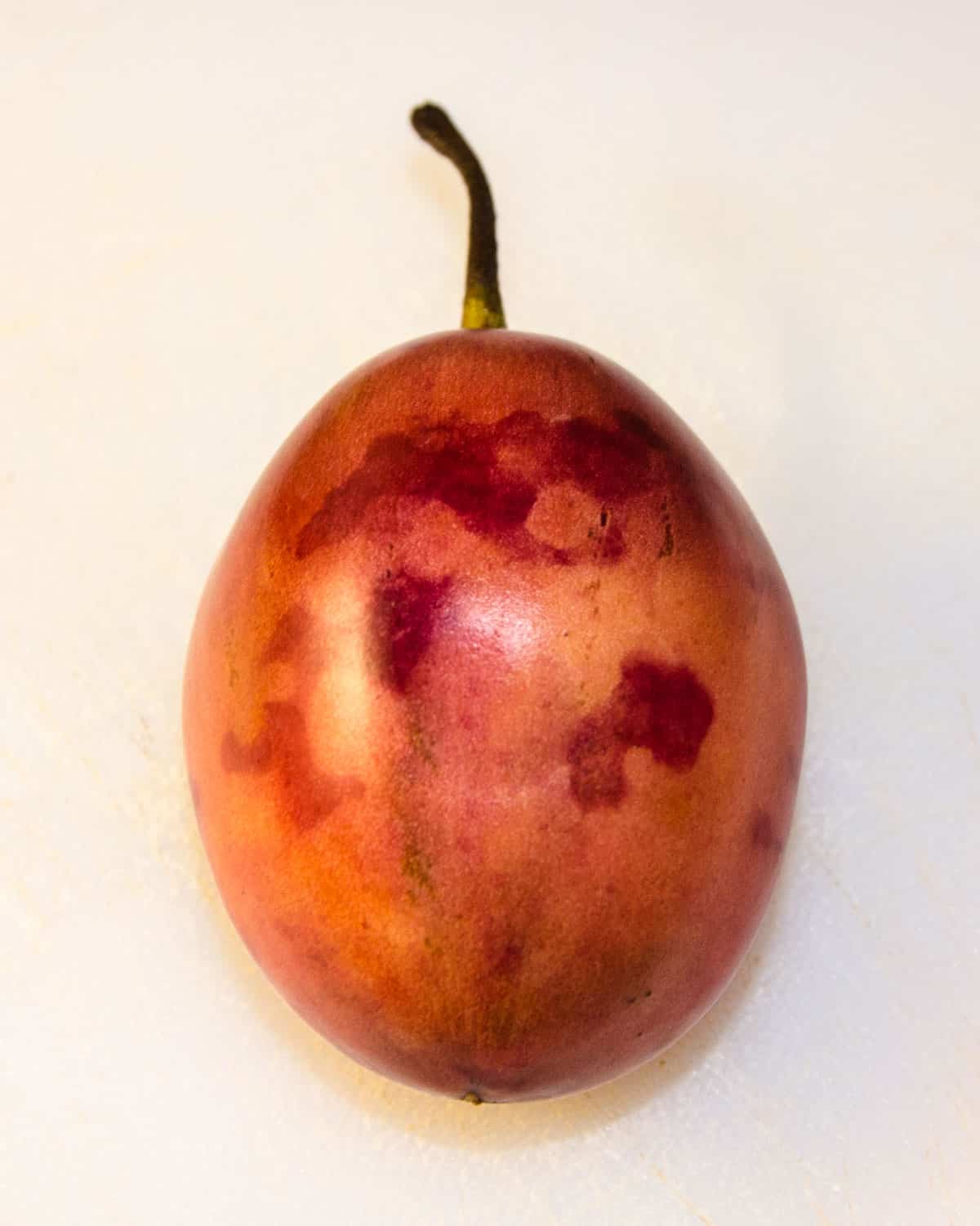Great news for tree tomato lovers! As of July 5, 2018, the Ecuadorian tomate de árbol can legally enter the United States!
On June 5, 2018, the US Embassy in Quito announced that the USDA is prepared to inspect and accept shipments of fresh tomate de árbol. That means we can all get ready to prepare this delicious, golden fleshed fruit into all kinds of wonderful dishes worthy of any Ecuadorian chef.
What is a Tree Tomato
The tomate de arból, or tree tomato, is native to South America. It likely originated in the Andes of Ecuador, Peru, or Bolivia though no one is quite sure.
This oblong-shaped fruit grows on small bushy trees where it hangs like baby eggplants. As a matter of fact, like eggplants, the tree tomato is from the nightshade family, joining other new world fruits like tomatoes and peppers. It has a bitter, thick skin ranging in color from golden orange to a dusky purple-red. Its firm, golden flesh is very high in pectin, making jams and jellies easy to set.
While the fruit is widely eaten in South America, it is lesser known in the United States. In the early 1900’s, an enterprising businessman imported seeds from Argentina. However, the fruit never took off as much more than an ornamental oddity. Today in the United States, the tree tomato grows in private gardens and perhaps a few small farms selling to local clients.
However, not all nations shunned the tree tomato. It arrived in New Zealand in 1891. Farmers commercialized tree tomato production in the 1920s. However, New Zealanders didn’t want to confuse their customers. For that reason, they gave it a commercial name, tamarillo.
How Does One Eat a Tree Tomato?
Ecuadorians eat tree tomatoes in three main ways. The first two are most common while the third I have seen only occasionally.
First, jugo de tomate de árbol is a favorite for breakfast. This juice is not extracted from the fruit by pressing. Instead, after peeling, the fruit is blended with fresh water to make a liquid beverage. The flavor has a faint tomato aftertaste. The juice is astringent and rarely sweet which is why most Ecuadorians add lots of sugar while blending. Another version uses milk in place of water.
Second, tree tomatoes are essential to the making of Ecuadorian ají, a hot sauce found on the table of almost every restaurant serving comida típica. In fact, this was my first foray into Ecuadorian cooking. Several versions exist and every chef claims to have their own trick up their sleeve. We have recipes for traditional ají, ají with fresh ginger, and peanut sauce ají.
Third, poached tree tomatoes make an excellent sweet-tart dessert. We often found this on offer as the final course at many a birding lodge dinner in the Ecuadorian Andes. Recipes usually rely on locally-made panela (a minimally processed brown sugar) and spices like cinnamon and cloves. The fruit is very tart and, even with sugar, I found my mouth puckering as I ate it.
The good news for our English-speaking audience is that due to this fruits popularity in New Zealand and Australia, there are many recipes already online. For example, they make tamarillo and apple crumble, roasted tamarillos to be served with roasted meats, tamarillo chutney, and tamarillo jam.
Where can I buy a Tree Tomato?
That is the million dollar question! While the fruit can legally enter the United States, it can often take time for Ecuadorian vendors to set up relationships with clients in the United States. If you want to see tree tomatoes in a store near you, now is the time to go ask the store manager about stocking their shelves with tomate de arbol. If they don’t know what you are talking about, share this article!
Our best guess says that large supermarket specializing in Latin American products will be the first to carry tomaté de arbol. Next, Whole Foods Market already sells a wide variety of exotic fruits from South America so adding the tree tomato to their lists of products is not that farfetched.
Other Names for the Tree Tomato
Just in case you find yourself trying to explain to a local market owner that you would like him to stock tree tomatoes, here is a handy list of common names:
Australia and New Zealand – tamarillo
Brazil – arvore do tomate, tomate de arvore, tomate francés
Bolivia – lima tomate, tomate de monte, sima
Colombia – pepino de árbol
Costa Rica – tomate cimarron
Ecuador – tomate dulce or tomate de árbol
Guatemala – caxlan pix
Honduras – tomate de palo
Rwanda – inbiyomoro
Venezuela – tomate francés

















This tree tomato recipe is really amazing. Thanks for sharing such an awesome recipe.
Glad you like the recipe!
We are in Cuenca, Ecuador right now (May, staying through June) and this fruit is everywhere — markets and street vendors. We bought a few this afternoon to see what they were, and had to look them up online to find a name for them. I find them plenty sweet for my taste, and would never add sugar. I can imagine lots of uses for them too. Salsa immediately came to mind when I first tried one. I’ll be nagging my local supermarkets in North Carolina to try and get some, though I worry about how well they will ship.
Let us know if you find them in the United States! And be sure to send us your best salsa recipe 😉 We would love to share it!
Just returned from Ecuador and had trying to find these guys at the top of my to-do’s. Thanks for pulling together all if this info! An immensely helpful start to my hunt for the currently elusive tomate de arbol!
Good luck! Please let us know if you manage to track them down. You can leave a comment here or any of our social media channels (though Facebook is by far the most popular: https://www.facebook.com/NotYourAverageAmerican/). So far, we have yet to see them hit any grocery stores in Washington DC 🙁
I just found them in a newly opened grocery store called La Placita in Bethel CT. Labeled “tomate de arbol”, the stickers said tree tomato. They had a wide selection of South American produce, and it all looked good!.
Hooray! This is great news! Thanks for letting us know!